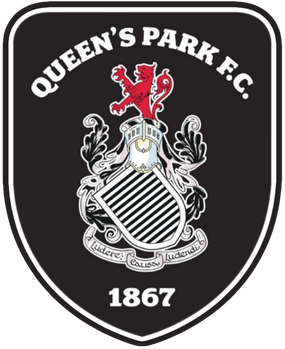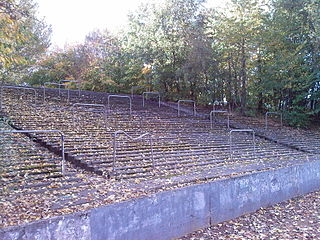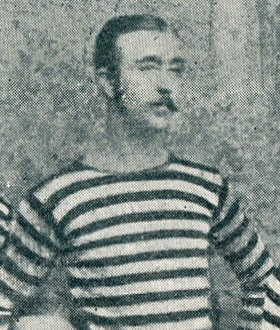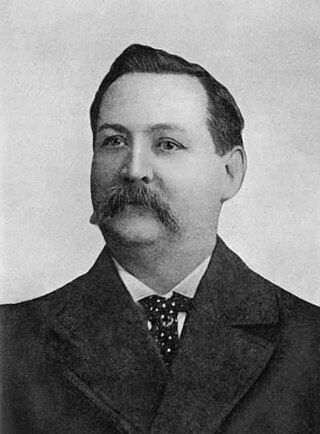Related Research Articles

Queen's Park Football Club is a Scottish professional football club, based in Glasgow, which plays in the Scottish Championship, the second tier of the Scottish football pyramid. Queen's Park is the oldest association football club in Scotland, having been founded in 1867, and is the 10th oldest in the world.

Cathkin Park is a municipal park in Glasgow, Scotland. The park is maintained by the city's parks department, and it is a public place where football is still played. The park contains the site of the second Hampden Park, previously home to the football clubs Queen's Park and Third Lanark. The site of the original Hampden Park is just to the west.
Clydesdale F.C. was a nineteenth-century Glasgow-based football club, which was attached to Clydesdale Cricket Club.
Renton Football Club was a football club based in Renton, West Dunbartonshire, Scotland. Formed in 1872, it was a prominent team in the early history of Scottish football, and was one of the teams that featured in the first ever Scottish Cup fixture. It won the competition twice, in 1885 and 1888, and was also runners-up three times. Its 6–1 win against Cambuslang in 1888 is the joint record win in a Scottish Cup final.
The Combination Game was a style of association football based around teamwork and cooperation. It would gradually favour the passing of the ball between players over individual dribbling skills which had been a notable feature of early Association games. It developed from "scientific" football and is considered to be the predecessor of the modern passing game of football. It originated in Britain and its origins are associated with early clubs: Sheffield FC, The Royal Engineers AFC, Queen's Park FC and Cambridge University AFC. Each of these claimants is supported by retrospective accounts from men who were notable in the early history of football. They are considered below in the order of earliest contemporary evidence of "scientific" football playing styles.

Charles Campbell was a Scottish footballer of the 1870s and 1880s who played for, and captained, Queen's Park and the Scotland national team.

William Allan Lambie was a Scottish footballer of the 1880s and 1890s.
Thistle Football Club was a 19th-century football club based in Glasgow. The club was briefly a member of the Scottish Football League Division Two, and has been described as the most insignificant and least successful to have entered the league. They played at Braehead Park during their Scottish League season.
Eastern Football Club was a 19th-century football club based in Glasgow, Scotland. It was one of the founder members of the Scottish Football Association (SFA) and one of the sixteen teams to participate in the inaugural season of the Scottish Cup.

Robert Smith was a Scottish footballer who played for Scotland against England in the first official international matches in 1872 and 1873, as well as three appearances in the earlier unofficial matches. He was a member of the Queen's Park and South Norwood clubs, and was prominent in the early history of Queen's Park.

The 1877 Scottish Cup Final was the fourth final of the Scottish Cup and the final of the 1876–77 Scottish Cup, the most prestigious knockout football competition in Scotland. The original match took place at Hamilton Crescent on 17 March 1877 and was contested by Vale of Leven and Rangers. The match was the first final to require two replays to decide a winner.

William Sellar was a Scottish footballer, who played for Queen's Park, Battlefield, Rangers and Scotland.
Airdrie Football Club was a Scottish association football club based in the town of Airdrie, Lanarkshire.
Pollokshields Athletic F.C. was a Scottish football team, based in the Pollokshields district of Glasgow.
Hearts of Beath F.C. was a Scottish football club.
Battlefield Football Club, often referred to as The Battlefield, was a 19th-century football club based in Langside, in Glasgow. The club took its name from the site of the Battle of Langside in 1568.
Queen's Park Juniors Football Club was a 19th-century football club based in Glasgow.
Alclutha Football Club was a football club based in Dumbarton, Scotland. From 1883 the club was called Dunbritton Football Club.
Methlan Park Football Club was an association football club based in the town of Dumbarton, in West Dunbartonshire.
References
- ↑ "Hamilton Gymnasium". Hamilton Advertiser: 2. 26 November 1870.
- ↑ "Proposed Gymnasium". Hamilton Advertiser: 2. 12 May 1866.
- ↑ "Amateur Concerts". Hamilton Advertiser: 2. 29 December 1866.
- ↑ "Hamilton Gymnasium". Hamilton Advertiser: 2. 10 April 1869.
- ↑ "Hamilton Gymnasium". Hamilton Advertiser: 2. 6 May 1871.
- ↑ "Hamilton". Glasgow Herald: 3. 6 May 1869.
- ↑ "Hamilton". Glasgow Herald: 6. 2 June 1869.
- ↑ Robinson, Richard (1920). History of the Queen's Park Football Club 1867 - 1917, chapter 7. Glasgow: Hay Nisbet.
- ↑ Robinson, Richard (1920). History of the Queen's Park Football Club 1867 - 1917. Glasgow: Hay Nisbet. p. 37.
- ↑ Sanders, Richard (2010). Beastly Fury, The Strange Birth of British Football. United Kingdom: Bantam. p. 69.
- ↑ Robinson, Richard (1920). History of the Queen's Park Football Club 1867 - 1917, chapter 7. Glasgow: Hay Nisbet.
- ↑ "Hamilton Gymnasum Versus Queen's Park Foot-Ball Club". Glasgow Herald: 4. 10 August 1869.
- ↑ "Matches played on Saturday". Glasgow Herald: 5. 16 August 1870.
- ↑ "Football". Glasgow Herald: 7. 27 September 1870.
- ↑ "Football Match". Hamilton Advertiser: 2. 5 November 1870.
- ↑ "Hamilton Gymnasium". Hamilton Advertiser: 2. 6 May 1871.
- ↑ "The Gymnasium". Hamilton Advertiser: 2. 20 April 1872.
- ↑ Robinson, Richard (1920). History of the Queen's Park Football Club 1867 - 1917, chapter 7. Glasgow: Hay Nisbet.
- ↑ Robinson, Richard (1920). History of the Queen's Park Football Club 1867 - 1917, chapter 7. Glasgow: Hay Nisbet.